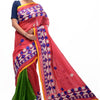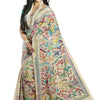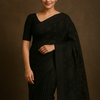The Essential Raw Materials Used in Kantha Stitch Saree

Kantha Stitch Sarees are more than just a fashion statement; they are a symbol of culture, history, and craftsmanship, intricately woven with love and tradition. But what makes these sarees so special? The secret lies in the raw materials used. In this article, we’ll explore the materials that breathe life into a Kantha Stitch Saree, unravel the frequently asked questions surrounding them, and dive deep into their significance.
Introduction
Kantha Stitch Sarees, known for their fine embroidery and intricate designs, are a hallmark of India’s rich textile heritage. Originating from West Bengal and Bangladesh, these sarees have transcended time and tradition, evolving into a blend of artistry and sustainable fashion. What makes them even more intriguing are the raw materials that form the foundation of each saree. From the choice of fabric to the threads used, every element plays a pivotal role in defining the saree's elegance and durability.
In this blog, we will break down the key raw materials used in crafting these masterpieces, answering frequently asked questions, and highlighting the most critical aspects of Kantha Stitch Sarees. Whether you're a textile enthusiast, a fashion lover, or a curious reader, this guide will give you insights into the world of Kantha Stitch Sarees.
What Are the Raw Materials Used in Kantha Stitch Sarees?
The raw materials for Kantha Stitch Sarees can be categorized into two primary components: the fabric and the threads. Let’s dive into each of these materials and understand their importance.
- Fabric: The Canvas of Creativity
The fabric used in Kantha Stitch Sarees serves as the foundation for intricate embroidery work. Typically, the following types of fabric are preferred:
- Silk: One of the most luxurious materials, silk gives Kantha sarees a rich and elegant look. Its smooth texture allows for fine and detailed embroidery. Silk is also durable, making it an ideal choice for special occasions.
- Cotton: Known for its breathability and comfort, cotton is another popular choice for Kantha Stitch Sarees. It offers a more casual, everyday wear appeal, perfect for the humid climates of India and Bangladesh. Cotton's absorbent nature allows the saree to drape beautifully.
- Tussar Silk: This type of silk is slightly rougher than regular silk but carries a rustic charm. Tussar silk sarees with Kantha embroidery are often sought after for their unique texture and cultural significance.
- Georgette and Chiffon: These lightweight, sheer fabrics are also used for modern interpretations of Kantha sarees, providing a flowy, delicate look. Though less traditional, they are highly popular in contemporary fashion.
- Threads: The Soul of Kantha Embroidery
The magic of Kantha stitch lies in the threads that transform the fabric into an embroidered masterpiece. The threads used are as crucial as the fabric, as they determine the durability, brightness, and precision of the stitch.
- Cotton Threads: Cotton threads are widely used for Kantha embroidery due to their availability and ease of use. They come in various colors, allowing artisans to create vibrant, multicolored designs. Cotton threads are preferred for their softness and the seamless blend they offer with cotton fabrics.
- Silk Threads: For more luxurious and glossy finishes, artisans turn to silk threads. These threads give the Kantha work a shiny and elegant touch, perfect for special occasions. When paired with silk fabric, the result is a mesmerizing sheen that elevates the overall appearance of the saree.
- Metallic Threads (Zari): Though not traditionally a part of Kantha, modern variations sometimes incorporate metallic threads or Zari. This addition provides a touch of sparkle and is typically used in bridal or festive Kantha sarees to give them a royal, ornate look.
- Dyes: Adding Vibrance
The vibrant colors of a Kantha Stitch Saree come from the dyes used on both the fabric and the threads. Traditionally, natural dyes derived from plants and minerals were used. Today, a combination of natural and synthetic dyes are applied to achieve more long-lasting and vibrant hues.
- Natural Dyes: These include indigo, turmeric, and madder root, which provide earthy tones. Natural dyes are eco-friendly and resonate with the sustainability ethos of traditional Kantha.
- Synthetic Dyes: To offer a wider color palette and ensure durability, many artisans now use synthetic dyes. These dyes help prevent fading and enhance color consistency.
Frequently Asked Questions
- Why is silk so popular in Kantha Stitch Sarees?
Silk's smooth texture makes it ideal for fine embroidery work, and its luxurious appearance is perfect for festive and formal occasions.
- Can cotton sarees with Kantha work be worn daily?
Yes, cotton Kantha sarees are lightweight and comfortable, making them ideal for casual and daily wear.
- How do natural dyes affect the quality of a Kantha saree?
Natural dyes provide an eco-friendly option and produce rich, earthy tones. However, they may fade faster than synthetic dyes if not cared for properly.
- Are metallic threads traditionally used in Kantha embroidery?
No, metallic threads like Zari are not traditionally used but have become popular in modern interpretations of Kantha for a more ornate look.
The Importance of Sustainable Raw Materials
One of the distinguishing factors of Kantha Stitch Sarees is their sustainable nature. Recycled and upcycled fabrics were initially used to create Kantha quilts, with the embroidery serving as a way to extend the life of old garments. This sustainability ethos continues today, with many artisans opting for eco-friendly dyes and organic fabrics.
Using materials like cotton and natural dyes aligns with the growing global trend of eco-conscious fashion. As consumers become more aware of the environmental impact of their choices, the demand for sustainably produced Kantha sarees has increased.
Conclusion
The art of crafting a Kantha Stitch Saree is deeply rooted in tradition, with each piece telling a story of culture, sustainability, and artistry. The choice of fabric, threads, and dyes all play a crucial role in bringing the saree to life. From luxurious silk sarees for festive occasions to the everyday elegance of cotton, the raw materials define the versatility and timeless appeal of Kantha Stitch Sarees.
Whether you’re looking to add a unique piece to your wardrobe or appreciate the craftsmanship behind these works of art, understanding the materials used helps you make more informed and sustainable choices. With eco-friendly options gaining popularity, a Kantha Stitch Saree is not just a fashion statement; it's a testament to the beauty of sustainable art.
-
Posted in
kantha stich saree






